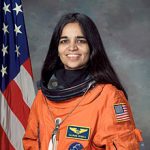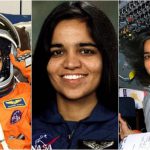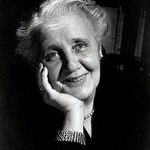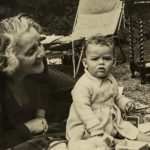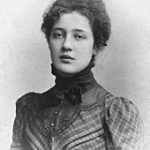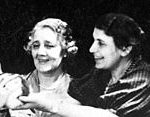Hey Everyone,
Here we are with another episode. The start is a real tearjerker. Hope you enjoy!
- NASA Photo
- The crew of STS-107 in October 2001. From left to right: Brown, Husband, Clark, Kalpana Chawla, Anderson, McCool, Ramon
- The Crew of Columbia (STS-107) in space
- Image Source : Google
Name: Kalpana Chawla
Dates: March 17, 1962 – February 1, 2003
What She Did: Astronaut
- Kalpana was born on March 17, 1962 in Karnal India.
- Kalpana’s father supported the family by selling coffee, candy, soaps, and performing odd jobs.
- Eventually, he became a self-taught technologist and engineer which allowed him to manufacture tires.
- Later, he married Kalpana’s mother and added Kalpana to their joint 16-member family.
- Kalpana’s parents were so busy that they didn’t have a chance to have her
naming ceremony. In Hinduism the traditional naming ceremony, or, Namkaran, typically takes place 12 days after the baby’s birth. - Instead of having a naming ceremony, Kalpana’s family called her by her pet
name ‘Monto’ at home. When Kalpana’s aunt took her to enroll in preschool, the principal asked for her name. The aunt said they were considering a few different names- Kalpana, Jyotsna, and Sunaina- but hadn’t decided. - The principal asked Kalpana which name she liked. Her name means “imagination.”
- Kalpana grew up fascinated with aircraft and the sky. Her family would sleep on the roof of their home in the summer and Kalpana would stare up at the stars. She would also visit the local flying club near her house to watch the planes with her father, drawing pictures of them after.
- She even got to ride in a Pushpak and a glider. When planes from the club would fly over her house, she’d wave at them.
- Growing up, Kalpana rejected a lot of traditional feminine practices; she cut her hair short, didn’t wear makeup, refused to cook or do housework, and was often found wearing pants.
- In 1976, Kalpana graduated from the Tagore School. She excelled in school and went on to earn her Bachelor of Engineering degree in Aeronautical Engineering from Punjab Engineering College in Chandigarh, India.
- Her family supported her educational pursuits (though her Father needed some
convincing as this was all very unusual for a woman at the time.) She was the only woman in the Aeronautical Engineering program and became the first woman to graduate with that degree in the college’s history. - Kalpana continued her education in the United States, earning her Masters in Aerospace Engineering from the University of Texas Arlington in 1984.
- Then she earned her Master of Science in Mechanical Engineering in 1986 and finally her Ph.D in Aerospace Engineering in 1988 from the University of
Colorado, so she’s rolling in degrees. - She also had a Certificated Flight Instructor’s license and her Commercial Pilot’s licenses. While she’s accomplishing all of this, she also married Jean-Pierre Harrison in 1983.
- The first time Kalpana began imagining the possibility of space travel was when she was 11, when she saw the Viking lander on Mars in the 1980s. This opened up a whole new world for Kalpana and it’s no surprised she began working at NASA’s Ames Research Center in California researching computational fluid dynamics on vertical and short take-off and landing concepts.
- Then, in 1993, she became Vice President and Research Scientist of Overset Methods, Inc. specializing in simulation of moving multiple body problems. There, she was able to develop and implement efficient techniques to perform aerodynamic optimization, which is basically maximizing the performance of any given body like a wing by changing its shape.
- In 1991, Kalpana had become a naturalized U.S. citizen and applied for the NASA Astronaut Corps which is basically astronaut school. Becoming an astronaut was obviously an intensive pursuit leaving her no time to visit her family in India. The last time she visited them was in 1991.
- In 1995, she joined the corps and in 1996 was chosen for her first flight.
- Kalpana was part of a 6-astronaut crew that flew the Space Shuttle Columbia flight STS-87 with the goal of performing two extra vehicular activities (EVAs) and deploying the SPARTAN-201 experiment which was meant to use telescopes to study the sun.
- This mission marked a series of firsts:
- This was the first time that an EVA was performed from the Columbia.
- It also marked the first EVA conducted by a Japanese astronaut Takao Doi.
- Finally, with Kalpana acting as a Mission Specialist, she was the first Indian woman in space.
- The team shot into space on November 19 th , 1997, travelling over 6.5 million miles, orbiting the earth 252 times, and logging over 376 hours and 34 minutes in space.
- On the mission, Kalpana deployed the Spartan satellite. Unfortunately, it malfunctioned which required two other astronauts to leave the craft on a spacewalk to re-capture the satellite.
- NASA investigated the
incident for 5 months and identified that it was an error in the software that caused the issue, not Kalpana. - Kalpana also operated Columbia’s robot arm during the mission.
- The crew returned safely to Earth after their mission on December 5, 1997.
- In 2001, Kalpana was selected for her second mission to space as a mission specialist for the STS-107, once again aboard Space Shuttle Columbia. This would be its 28 flight.
- The purpose of the mission was to perform a variety of experiments
- The mission experienced several delays due scheduling issues and technical difficulties such as finding cracks in the shuttle engine flow liners.
- Finally, on January 16, 2003, Kalpana boarded Columbia with her 6 crewmembers, Commander Rick D. Husband, Pilot William C. McCool, Payload Commander Michael P. Anderson, Payload Specialist Ilan Ramon (who was also the first Israeli astronaut,) Mission Specialist David M. Brown, and Mission Specialist Laurel Blair Salton Clark.
- As Columbia launched into space, a piece of foam insulation broke from the shuttle’s external tank and hit the left wing of the orbiter. Damage like this had occurred before, but engineers suspected the damage could have been more serious.
- NASA managers performed a limited investigation, saying that
the crew couldn’t fix the problem anyway. Engineers made 3 requests for the Department of Defense to conduct imaging of the shuttle in orbit to examine the damage and determine its severity. NASA management wouldn’t honor the requests and actually intervened to stop the Department of Defense from helping. - The crew successfully reached space and performed over 80 experiments. While aboard Columbia, Kalpana had a conversation with the Prime Minister of India. He said “We are proud of you. Every single one of us.”
- When Columbia re-entered the Earth’s atmosphere on February 1, 2003, the damage from the foam block allowed hot atmospheric gasses to penetrate the damaged wing and destroy its internal structure.
- The shuttle became unstable and broke apart. The shuttle essentially disintegrated over Texas, killing all 7 crewmembers.
- The catastrophic reentry was broadcasted all over the world. Kalpana’s remains were identified and she was cremated and scattered at Zion National Park in Utah as per her wishes.
- Kalpana’s brother, Sanjay, said of her, “To me, my sister is not dead. She is immortal. Isn’t that what a star is? She is a permanent star in the sky. She will always be up there where she belongs.”
- In 2013, retired NASA official Wayne Hale recalled what the Director of Mission Operations, Jon C. Harpold shared with him before the disaster which Hale said captured the mindset of many at NASA, including the astronauts: “You know, there is nothing we can do about damage to the thermal protection system. If it had been damaged, it’s probably better not to know. I think the crew would rather not know. Don’t you think it would be better for them to have a happy successful flight, and die unexpectedly during entry than to stay on orbit, knowing that there was nothing to be done, until the air ran out?”
LEGACY
- Kalpana Chawla has been posthumously awarded:
- The NASA Space Flight Medal
- The NASA Distinguished Service Medal
- The Defense Distinguished Service Medal
- The Congressional Space Medal of Honor
- On February 5, just a few days after the Columbia disaster, the Prime Minister of India declared that all Indian meterological satellites, or METSAT, would now be renamed, KALPANA. Many streets, buildings, a scholarship, planetarium, and even an asteroid have been named after Kalpana. There is actually an asteroid named after each member of the Columbia crew.
- Kalpana Chawla is still considered a national hero in India.
![]()
- Melanie Klein in 1952
- Melanie Klein with her grandson Michael in 1938.
- Melanie Klein c. 1900
- Melanie Klein and Anna Freud
Name: Melanie Klein
Dates: March 30, 1881 – September 22,1960
What She Did: Author and Psychoanalyst
- Born the fourth and final child of Jewish parents Moriz and Libussa Reizes, Melanie would spend most of her early life in Vienna, Austria.
- Her childhood was relatively happy, although there was often a lack of affection in her family. In her experience, it was her mother who ran the household and her father who was her intellectual mentor.
- Two of her siblings died at young ages and this has been said to have contributed to the depression that Klein struggled with her entire life.
- Her older sister, Sidoine, died at the age of 8 of tuberculosis. Sidoine taught Klein to read and do arithmetic, and the two sisters were very close.
- Her father, Moriz Reizes, died at the age of 72 when Klein was 18.
- At the age of twenty-one she married industrial chemist Arthur Klein, Arthur was a friend of her brother and her mother’s second cousin.
- Melanie and Arthur had three children: Meliita, Hans, and Erich. Melanie suffered from clinical depression, with these pregnancies taking quite a toll on her.
- This, in conjunction with an unhappy marriage, soon led Melanie to seek out means of treatment.
- Shortly after her family moved to Budapest in 1910, Melanie began a course of therapy with psychoanalyst Sándor Ferenczi. It was during their time together that Melanie expressed interest in the study of psychoanalysis.
- Encouraged by Ferenczi, Melanie began her studies by the simple observations of her own children.
- Until this point very minimal documentation existed on the topic of psychoanalysis concerning children, and Melanie seized the opportunity by developing her play technique.
- Comparable to that of free association in adult psychoanalysis, Melanie’s play technique sought to interpret the unconscious meaning behind the play and interaction of children.
- She began familiarizing herself with Freud’s ‘On Dreams’ in 1914. She then met Freud in Budapest where she published her first paper “The Development of the Child”. She became a member of the Hungarian Psychoanalytic Society in 1919, but had to leave Hungary due to anti-Semitism.
- During 1921, in the wake of a dissolving marriage, Melanie moved to Berlin where she joined the Berlin Psycho-Analytic Society under the tutelage of Karl Abraham.
- Although Abraham supported her pioneering work with children, neither Melanie nor her ideas received much support in Berlin.
- As a divorced woman whose academic qualifications did not even include a bachelor’s degree, Melanie was a visible iconoclast within a profession dominated by male physicians.
- Despite this impediment, Melanie’s up and coming work possessed a strong influence on the developing theories and techniques of psychoanalysis, particularly in Great Britain.
- Klein was one of the first to use traditional psychoanalysis with young children. She was innovative in both her techniques (such as working with children using toys) and her theories on infant development.
- Klein established a highly influential training program in psychoanalysis.
- By observing and analyzing the play and interactions of children, Klein built onto the work of Freud’s unconscious mind.
- Her dive into the unconscious mind of the infant yielded the findings of the early Oedipus complex, as well as the developmental roots of the superego.
- Klein’s theoretical work incorporates Freud’s belief in the existence of the “death pulsation”, reflecting the fact that all living organisms are inherently drawn toward an inorganic state, and therefore, in an unspecified sense, contain a drive towards death.
- In psychological terms, Eros (properly, the life pulsation), the postulated sustaining and uniting principle of life, is thereby presumed to have a companion force, Thanatos (death pulsation), which seeks to terminate and disintegrate life.
- Both Freud and Klein regarded these biomental forces as the foundations of the psyche.
- These primary unconscious forces, whose mental matrix is the Id, ego and superego.
- .While Freud’s ideas concerning children mostly came from working with adult patients, Klein was innovative in working directly with children, often as young as two years old. Klein saw children’s play as their primary mode of emotional communication.
- While observing children play with toys such as dolls, animals, plasticine, pencil and paper, Klein documented their activities and interactions, then attempted to interpret the unconscious meaning behind their play.
- Following Freud she emphasized the significant role that parental figures played in the child’s fantasy life, and considered that the timing of Freud’s Oedipus complex was incorrect. Contradicting Freud, she concluded that the superego was present from birth.
- After exploring ultra-aggressive fantasies of hate, envy, and greed in very young and disturbed children, Melanie proposed a model of the human psyche that linked significant oscillations of state, with the postulated Eros or Thanatos pulsations.
- She named the state of the psyche in which the sustaining principle of life is in domination the depressive position. This is considered by many to be her great contribution to psychoanalytic thought.
- She later developed her ideas about an earlier developmental psychological state corresponding to the disintegrating tendency of life, which she called the paranoid-schizoid position.
- Klein’s insistence on regarding aggression as an important force in its own right when analysing children brought her into conflict with Freud’s daughter Anna Freud, who was one of the other prominent child psychotherapists in continental Europe but who moved to London in 1938 where Klein had been working for several years.
- Many controversies arose from this conflict, and these are often referred to as the controversial discussions. Battles were played out between the two sides, each presenting scientific papers, working out their respective positions and where they differed, during war-time Britain.
- A compromise was eventually reached whereby three distinct training groups were formed within the British Psychoanalytical Society, with Anna Freud’s influence remaining largely predominant in the US.
- The school of Kleinianism was the first branch of the proverbial Freudian tree to remain part of the psychoanalytic movement.
- Klein is known to be one of the primary founders of object relations theory.
- This theory of psychoanalysis is based on the assumption that all individuals have within them an internalized, and primarily unconscious realm of relationships.
- These relationships refer not only to the world around the individual, but more specifically to other individuals surrounding the subject. Object relation theory focuses primarily on the interaction individuals have with others, how those interactions are internalized, and how these now internalized object relations affect one’s psychological framework.
- The term “object” refers to the potential embodiment of fear, desire, envy or other comparable emotions. The object and the subject are separated,[7] allowing for a more simplistic approach to addressing the deprived areas of need when used in the clinical setting.
- Melanie died of colon cancer on September 22, 1960
